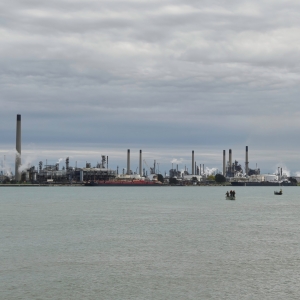The Stream, July 7, 2021: Study Finds Planting Forests in Europe Could Offset Drought There
YOUR GLOBAL RUNDOWN
- A new study finds that planting trees in Europe could offset CO2 emissions and help the continent adapt to worsening drought conditions.
- A water utility in the United Kingdom faces charges for deliberately dumping sewage into protected coastal waters for years.
- Hawaii confronts unusually dry conditions after its wettest winter in three decades.
- As glaciers melt, flooding on sunny days will become more common, threatening nearby residential areas in places like Juneau, Alaska.
Detroit residents are voicing concerns over repeated floods spurred by aging water infrastructure.
“I don’t want to talk about the damage. I want to talk about the solution.” – Vernon Allen, a 78-year-old Detroit resident whose home recently flooded for the fourth time in 10 years. Repeated flooding is common in Detroit-area homes, and residents are pleading with city officials to upgrade water infrastructure, the Detroit Free Press reports. After major flooding swept across parts of Detroit in late June, officials say $1.7 billion of capital investment is needed over the next five years.
- Why it matters: Detroit officials partially blamed the floods on power outages in the city’s pumping system, but even after the system regained power, they had nowhere to put the water. In other words, the drainage system was working as it was designed to; it just isn’t equipped to handle that much rain. Experts say one remedy to the problem is more natural infrastructure like urban parks that double as stormwater retention ponds.
IN RECENT WATER NEWS
Constant, Compounding Disasters Are Exhausting Emergency Response
Fires, droughts, floods, power outages. The interval between disasters is shortening, or in some cases, disappearing all together.
It’s not just one fire. It’s several — at the same time. Or, it’s a fire and power shutoffs happening during a drought in a region that still hasn’t recovered from the last dry cycle.
The acceleration of disaster is repeating worldwide, in part because vulnerable people and developments are encroaching on hazardous terrain. Landslides in the unstable Himalaya mountains in recent years have demolished newly built hydropower stations and killed hundreds, including more than 200 dead or missing in February from the Chamoli disaster. But the acceleration is also occurring because a supercharged climate is churning up more powerful hurricanes, more punishing droughts, more oppressive heat waves — altogether more environmental and water-related risk.
Dealing With The Soup of Chemicals That Can Get Into Your Drinking Water
All the things that go down the drain and end up at the waste water treatment plant are not removed there. Some of the industrial byproducts that end up in sewers, the agricultural chemicals that runoff farmland, and pharmaceuticals that pass through our bodies all can end up in our streams and lakes. It’s a soup of chemicals. They’re difficult to keep out of drinking water.
Dealing with chemicals seems more complicated for regulators. Only recently PFAS was discovered in drinking water, but it had been there for decades. More than likely there are other chemicals not yet detected.
Chemicals in water can mix. That’s where dealing with pollutants really falls short.
U.K. Water Utility Faces Charges For Discharging Sewage Into Protected Waters
Southern Water, a utility in the United Kingdom, is awaiting sentencing after purposefully discharging large amounts of raw sewage into protected coastal waters for years, the Guardian reports. The court was told that the case is the biggest investigation in the history of the government’s Environment Agency. Southern Water failed to report its illegal discharges to the agency, sending investigators on a hunt to find the source of contamination that caused the quality of shellfish in the area to plummet. Eventually, the criminal inquiry led them to 17 Southern Water wastewater treatment plants in north Kent County.
TODAY’S TOP WATER STORIES, TOLD IN NUMBERS
7.6 PERCENT
A study, published in Nature Geoscience, found that planting new forests across all available agricultural land in Europe could help the continent adapt to worsening drought. As trees grow, they naturally absorb more CO2, offsetting rapidly rising CO2 emissions. Additionally, planting forests could increase rainfall in the summer by an average of 7.6 percent, reducing the risk of drought during the hottest months of the year.
75,107 ACRES
Between 2018 and 2020, 75,107 acres across Hawaii have been lost to wildfires. The New York Times reports that the island state faces conditions similar to those throughout the American West— an unusually dry summer is leading to an uptick in devastating wildfires. The drought follows the wettest winter the state has seen in three decades. The rain nourished grass species like guinea and kikuyu, which are now burning easily in the summer heat. Authorities are urging residents to conserve water in at-risk areas.
ON THE RADAR
Sunny day floods will become more common in glaciated landscapes as climate change continues to warm the planet, scientists predict. Inside Climate News reports that researchers from the University of Alaska Southeast, the U.S. Geological Survey, and the National Weather Service are working in Juneau, Alaska, to determine where the newest glacial lake floods will surge. Flooding in places like Juneau is particularly concerning due to the proximity of residential areas.
Jane is a Communications Associate for Circle of Blue. She writes The Stream and has covered domestic and international water issues for Circle of Blue. She is a recent graduate of Grand Valley State University, where she studied Multimedia Journalism and Women, Gender and Sexuality Studies. During her time at Grand Valley, she was the host of the Community Service Learning Center podcast Be the Change. Currently based in Grand Rapids, Michigan, Jane enjoys listening to music, reading and spending time outdoors.







Leave a Reply
Want to join the discussion?Feel free to contribute!